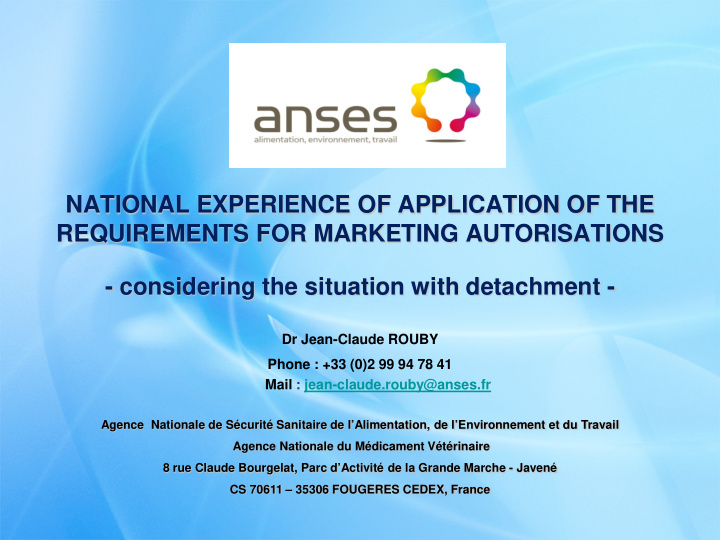



NATIONAL EXPERIENCE OF APPLICATION OF THE REQUIREMENTS FOR MARKETING AUTORISATIONS - considering the situation with detachment - Dr Jean-Claude ROUBY Phone : +33 (0)2 99 94 78 41 Mail : jean-claude.rouby@anses.fr Agence Nationale de Sécurité Sanitaire de l’Alimentation, de l’Environnement et du Travail Agence Nationale du Médicament Vétérinaire 8 rue Claude Bourgelat, Parc d’Activité de la Grande Marche - Javené CS 70611 – 35306 FOUGERES CEDEX, France
CONTENT • PROBLEM STATEMENT • RISK-TAKING synthesis • COUNTERPART(S) • AREA FOR DEBATE Disclaimer: the views expressed in this presentation are entirely mine and do not necessarily represent the views of other persons or institutions 2
PROBLEM STATEMENT - 1 Problem(s) need to be well-posed to avoid putting the cart before the horse & taking the wrong decisions 3
PROBLEM STATEMENT - 2 What is/are the problem(s)? Vaccine industry in financial difficulties? Current regulation too demanding/unadapted? Procedures too complicated? Too much paper work? Availability - No market/limited market for (some) vaccines? Others? A combination of these? 4
PROBLEM STATEMENT - 3 • Problem(s) to be reported in an objective manner (not just an assertion) Stakeholders must be convinced. • Solution(s) depend(s) on the causes Is the solution scientific, procedural, regulatory or financial? Ex: limited market – EU versus US approach (http://www.gpo.gov/fdsys/pkg/FR-2009-08-26/html/E9- 20553.htm) 5
PROBLEM STATEMENT - 4 Make sure that the problem statement is not oversimplified. Examples: Too much autologous vaccines because not enough fully authorised vaccines. Relationship between both? See US situation. Full authorisations on which basis then? ‘minor use’ is synonymous with ‘limited market’. Use can be minor, but still financially profitable. 6
PROBLEM STATEMENT - 5 Make sure that the solutions are adapted, proportionate and sound. Examples: Reduction of requirements accepted in case of emergency Avian Influenza REFLECTION PAPER: MINIMUM DATA REQUIREMENTS FOR AN AUTHORISATION UNDER EXCEPTIONAL CIRCUMSTANCES FOR VACCINES FOR EMERGENCY USE IN BIRDS AGAINST H5 AND/OR H7 HIGHLY PATHOGENIC AVIAN INFLUENZA VIRUS EMEA/CVMP/IWP/46853/2006 7
PROBLEM STATEMENT - 6 Reduction of requirements accepted for some economically important diseases Foot-and-mouth disease, Bluetongue GUIDELINE ON REQUIREMENTS FOR AN AUTHORISATION UNDER EXCEPTIONAL CIRCUMSTANCES FOR VACCINES FOR EMERGENCY USE AGAINST BLUETONGUE EMEA/CVMP/IWP/220193/2008 GUIDELINE ON DATA REQUIREMENTS FOR MULTI-STRAIN DOSSIERS FOR INACTIVATED VACCINES AGAINST AVIAN INFLUENZA (AI), BLUETONGUE (BT) AND FOOT-AND-MOUTH DISEASE (FMD) EMEA/CVMP/IWP/105506/2007 8
PROBLEM STATEMENT - 7 Reduction of requirements accepted for ‘limited market’ diseases. GUIDELINE ON DATA REQUIREMENTS FOR IMMUNOLOGICAL VETERINARY MEDICINAL PRODUCTS INTENDED FOR MINOR USE OR MINOR SPECIES/LIMITED MARKETS EMEA/CVMP/IWP/123243/2006-REV.2 Reductions were scientifically contained, to prevent risk(s) No reductions of requirements for vaccines against standard diseases. 9
PROBLEM STATEMENT - 8 National example: viral haemorrhagic disease-new variant (VHD-nv) in rabbits. High mortality in some french farms. Vaccines against ‘classical’ VHD not efficacious against VHD-nv. No interest to develop a vaccine against VHD-nv. ⇒ Temporary authorisation for a VHD-nv vaccine in March 2013 (incomplete dossier, very small company). 10
PROBLEM STATEMENT - synthesis (1) Flexibility of competent authorities already shown to be possible. BUT: 1 - If the disease is economically important and/or politically sensitive, decision-makers & risk- managers are disregarding the risk(s) taken, although millions of doses are sold within a short time frame, making the likelihood of the threat occuring & consequences significant. 11
PROBLEM STATEMENT - synthesis (2) 2 - If the market is limited, decision-makers and risk-managers are disregarding the risk(s) taken, as availability becomes the main priority, although the outcome could become disastrous. 3 - In all other cases (majority of cases), full data set necessary. 12
PROBLEM STATEMENT - synthesis (3) → Isn’t there currently a contradiction between situations? → Up to now, only vaccine industry and assessors secured the vaccines, although ‘hard’ law remained identical. What if a disaster would has occurred? 13
RISK-TAKING - 1 In case of reduction of requirements: Is the risk correctly perceived by risk-managers & decision-makers? Fundamental features of vaccines and of assessments not understood. Economics outweighs scientific guarantees. Is the concept of risk unequivocal? rabies (public health), bluetongue (productive economy), canine parvovirus (animal health with strong affective dimension), … 14
RISK-TAKING - 2 In case of reduction of requirements: Which risks are decision-makers & risk-managers willing to take? Nature, frequency, magnitude, seriousness: animal health, human health, economical, political, … Are decision-makers & risk-managers willing to take their responsibilities? Not shifting the burden on scientists/assessors. Which risks is the EU society willing to take? Societal problem. 15
COUNTERPART(S) - 1 In case of reduction of requirements: • There must be a global benefit for EU society, outweighing the risk(s) taken because of lack of data. • The choice of the beneficiary is a political choice. 16
COUNTERPART(S) - 2 Global benefit: For whom exactly? Vaccine industry? Animals? Farmers? Pet owners ? Food production sector? ... In which circumstances? Public/animal health? Trade? Economy? Employment? … How? Increased vaccine availability? Increased therapeutic arsenal? Increased R&D? Improved vaccines? Decreasing antibioresistance? Reduced vaccine costs? … 17
AREA FOR DEBATE • “The most serious mistakes are not being made as a result of wrong answers. The truly dangerous thing is asking the wrong questions” - Peter Drucker, in “Men, Ideas & Politics” • Shouldn’t the requirements for vaccines be redesigned rather than reduced? Vaccines are not chemicals, but are treated in the same way: rather than thinking about reduction of requirements, one could think about looking at them and authorising them in another way… (authorisations could be given to active ingredients, consistency of production could replace control of finished products, …) 18
Requirements of PhEur. (5) 19
Recommend
More recommend